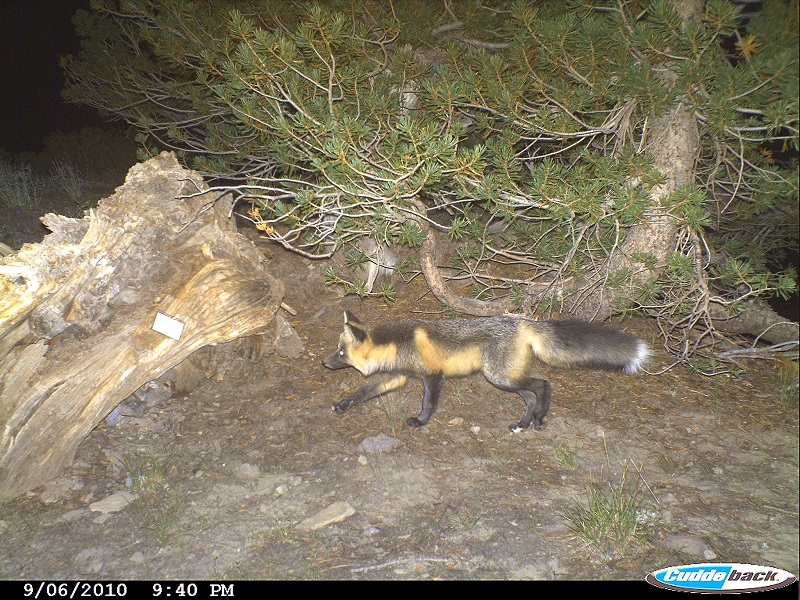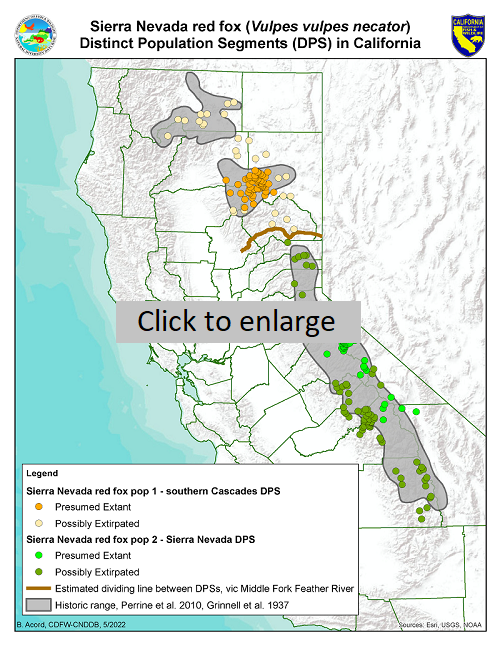
Sierra Nevada red fox near brush and rocks at night on the Stanislaus National Forest.
Photograph by US Forest Service (CC BY-NC 2.0)
The CNDDB has updated our species concept for Sierra Nevada red fox (Vulpes vulpes necator). Instead of one species record for Sierra Nevada red fox, CNDDB has split Sierra Nevada red fox into two species concepts representing the U.S. Fish and Wildlife Services’ two Distinct Population Segments (DPS) with different Federal legal status:
| Common Name |
Scientific Name |
State Status |
Federal Status |
Sierra Nevada red fox
southern Cascades DPS |
Vulpes vulpes necator pop.1 |
Threatened |
None |
Sierra Nevada red fox
Sierra Nevada DPS |
Vulpes vulpes necator pop.2 |
Threatened |
Endangered |
The Sierra Nevada red fox is a native montane red fox and one of California’s rarest mammals. The subspecies was originally described in 1900 based on a collection from the Big Whitney Meadow area of Inyo National Forest in 1891, hence “Sierra Nevada” red fox, but is known to range from the southern Sierra Nevada to Mount Hood in the Cascade Mountains of northern Oregon. In California, Sierra Nevada red foxes were historically known from the high Sierra Nevada Mountains from Sequoia National Forest to Tahoe National Forest, the Cascade Mountains near Mount Lassen, and into the eastern Klamath Mountains. The current consensus is that there is a small extant population near Lassen Volcanic National Park and a small population near Sonora Pass and Yosemite National Park. The State of California listed the Sierra Nevada red fox as Threatened under the California Endangered Species Act in 1980.
Recently the Sierra Nevada red fox was petitioned for listing under the Federal Endangered Species Act. In their assessment of native montane red foxes, the U.S. Fish and Wildlife Service determined there was two discrete Distinct Population Segments (DPS) of Sierra Nevada red fox: “a southern Cascade population in the Cascades Mountains of northern California and Oregon, and a Sierra Nevada population in the Sierra Nevada Mountains” (USFWS 2015, pages 61011-61013). Subsequently, the Service determined that listing of the southern Cascades DPS was not warranted, but that the Sierra Nevada DPS was Endangered (USFWS 2021).
To reflect the different legal status of the two populations in California, CNDDB has implemented the two population element concepts noted above. However, whereas the DPS determination is a recent evaluation of rather disjunct extant populations, CNDDB tracks historical records that are less clear in the delineation of the modern DPS concepts. To separate the historical Element Occurrences in the database, the Middle Fork Feather River to the town of Beckwourth and California Highway 70 east of that point was used as a dividing line between DPSs. Highway 70 is not meant to represent a real barrier to dispersal and does not carry any legal representation of the DPS split. This highway only serves as a convenient landmark delineating the two DPSs for data management purposes.

Resources:
- CDFW. 2022. Sierra Nevada red fox (web page).
- Grinnell, J., J. S. Dixon, and J. M. Linsdale. 1937. Fur-Bearing Mammals of California: Their natural history, systematic status, and relations to man. University of California Press, Berkeley, CA.
- Perrine, J. D., L. A. Campbell, and G. A. Green. 2010. Sierra Nevada red fox (Vulpes vulpes necator): A conservation assessment (PDF). USDA Forest Service report R5-FR-010. 52pp.
- U.S. Fish and Wildlife Service. 2015. 12-month finding on a petition to list Sierra Nevada red fox as an endangered or threatened species. Notice of finding [DPS] (PDF). Federal Register 80(195):60990-61028.
- U.S. Fish and Wildlife Service. 2018. Species status assessment report for the Sierra Nevada Distinct Population Segment of the Sierra Nevada red fox (PDF). 53 pages.
- U.S. Fish and Wildlife Service. 2021. Endangered species status for the Sierra Nevada distinct population segment of the Sierra Nevada red fox. Final Rule (PDF). Federal Register 86(146): 41743-41758.
- U.S. Fish and Wildlife Service. 2022. Sierra Nevada red fox (Vulpes vulpes necator), species profile. ECOS Environmental Conservation Online System.
- U.S. Forest Service. 2010. Sierra Nevada red fox fact sheet (PDF). Sierra Nevada red fox Interagency Working Group.
- U.S. National Park Service. 2018. Sierra Nevada red fox description and biology. Yosemite National Park.
- U.S National Park Service. 2020. Sierra Nevada red fox: one of the rarest mammals in California. Lassen Volcanic National Park